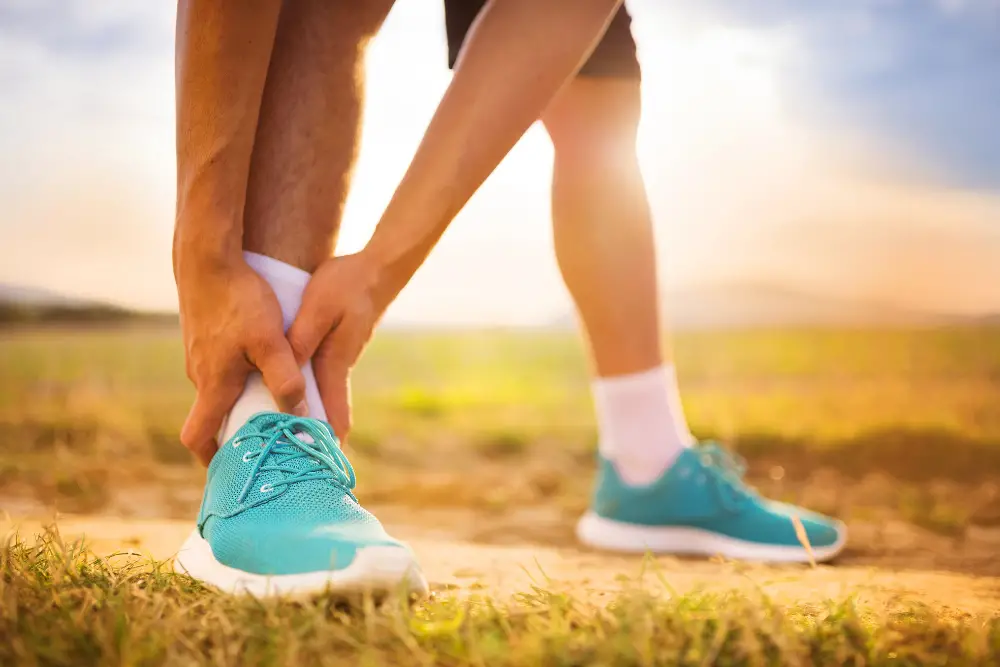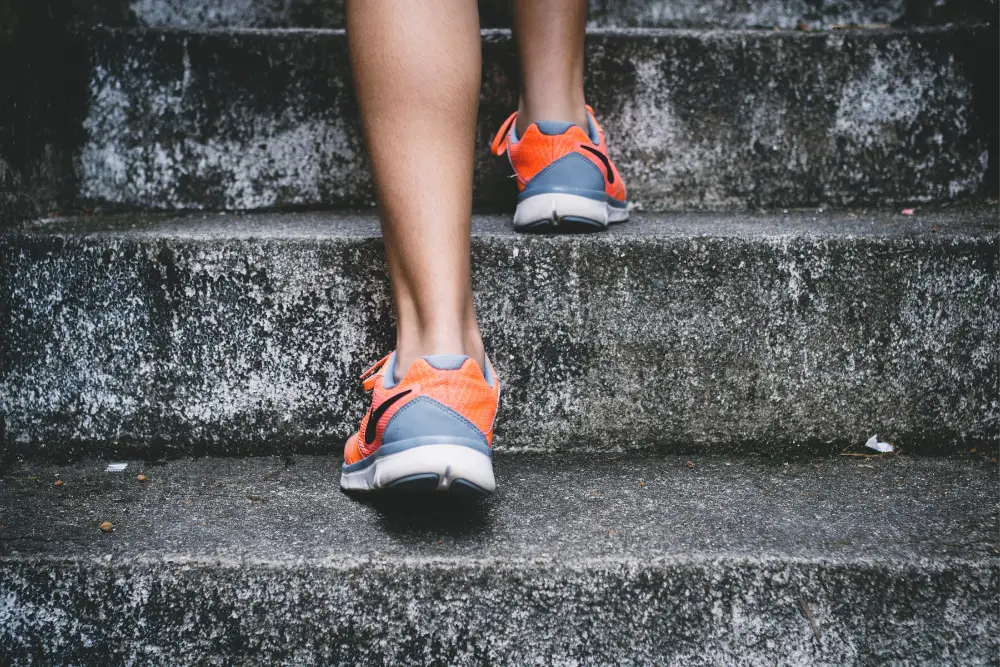When it comes to running, what’s slowing you down? Is it a lack of training or stamina? Poor-fitting shoes or a lack of motivation? Or, like millions of runners, are your weak ankles the main culprit?
If you’re struggling to get the miles in because your ankles can’t take the strain, you’re not alone. When we run, our leg muscles do the majority of the work. You may be surprised to learn just how many lower-body muscles take the strain when we run, too, especially our ankles.
If your muscle strength is letting you down, and you’re finding yourself more susceptible to ankle strains and sprains, you’re not alone. Incorporating ankle muscle workouts into your strength training may just be the push you need to increase your performance and reduce your risk of injury.
If you’re ready to find out more, stick with us to learn some of the best ways to strengthen your ankles for running.

Why Your Ankles Hurt From Running
Are your ankles feeling sore, tense, or weak from your run? There are a few reasons why your ankles might hurt after running:
Stress Fracture
Stress fractures can form in your muscle when your muscles cannot absorb the shock from the impact of repetitive exercise.
Shin splints, which are an irritation on the outer lining of the bone, are one of the primary forms of stress fracture. If left untreated, stress fractures can end up needing a cast and the treatment of a medical professional.
Do Shin Splints Go Away?
Shin splints may heal on their own if treated with ice and gentle stretching. Some shin splints can take between 3 to 6 months to heal, and you should avoid repetitive physical activity during the healing process.
Tendonitis
Tendons are the pieces of connective tissue that sit between your muscles and your bones. Tendonitis is the swelling of a tendon that can cause joint pain or stiffness. Several types of tendinitis can occur in the foot region and may make your ankles hurt when you run.
Arthritis
In most cases, arthritis in the ankles is caused by wear and tear of the joints. It can occur in runners of any age. Three types of arthritis can cause your feet or ankles to hurt: rheumatoid arthritis, post-traumatic arthritis, and osteoarthritis. With each type, the joint is weakened or damaged, which can cause pain, stiffness, and difficulty moving.
Ankle Instability
In some cases, you may just be suffering from weak ankles. Chronic ankle instability can develop if you’ve suffered from frequent ankle sprains. Ankle instability often feels like your ankles are ‘giving way’ when walking or running. You may suffer from regular discomfort, swelling, wobbly ankles, pain, or tenderness.
Common Ankle Injuries From Running
Running can cause several ankle injuries that shouldn’t be ignored, whether it’s from overtraining or bad mechanics. The ankle joint has complex and delicate biomechanics, making ankle injuries a common issue for runners. Below are some of the most common ankle injuries caused by running:
Sprain
Sprains cause damage to lateral or external ligaments. Sprains can be treated with rest to control pain, swelling, or inflammation, and most people recover within a few weeks to months.
Achilles Tendinopathy
This injury is caused to the band of tissue that runs down the back of your leg to your heel. It’s often caused by blunt trauma or muscle fatigue.
The Best Strength Exercises for Ankles
Now we’ve explored some of the most common causes of ankle sprain, and the injuries that can occur during exercise, let’s take a look at some of the ways you can strengthen your ankles and minimize the risk of injury.
Heel Walks
Heel walks can help you identify imbalances in the lower leg, especially in the Tibialis Anterior. To perform a heel walk, complete the following steps:
- Begin by standing with your feet together.
- Now, start to walk forward, only placing your heels on the ground when you walk.
- You’re now doing the heel walk! Continue to perform this exercise for the desired number of repetitions.

Ankling
Ankling is a warm-up exercise that focuses on the ankles and the hamstrings, calves, shins, and quads. This is a great exercise to increase your strength and ankle mobility. Let’s take a look at how to do this exercise below:
- Start by standing with your feet hip-distance apart, look straight ahead, and keep your upper body in a straight, upright position.
- Now, step forward with your right foot and land on the ball of your foot while standing up on your left leg.
- Next, shift your weight from your left leg to your right leg.
- To continue this exercise, carry on alternating sides and move forward.
Calf Raises
Calf raises are one of the best strength and conditioning exercises a runner can do. They’re also one of the most straightforward exercises known to man! There are a few variations of the calf raise, so let’s take a look at the two of the most common ones: the raised calf raise, and the weighted calf raise.
Standing Calf Raise
To do a standing calf raise, start on a yoga mat, and stand with your feet shoulder-width apart. Keep your back straight, your abs sucked in, and your shoulders back and down.
Now, raise your heels and keep your knees extended but not locked. When you’re standing on the tips of your toes, pause for a second (or as long as you can manage). Next, lower your heels back onto the ground and return to your starting position.
Weighted Calf Raise
The weighted calf raise is a step up from the traditional calf raise exercise. Once you’re accustomed to calf raises, the weighted calf raise can help you make this exercise more challenging.
Heel Raises
This simple exercise can help you strengthen your muscles and reduce the risk of injury when running. To perform the heel raise, do the following:
- Stand up with your feet around 10 centimeters apart, and have your hands resting lightly on a counter or another stable object in front of you.
- Now, raise your heels from the floor and keep your knees straight. Once you’re here, hold the position for around 6 seconds, and start lowering your heels slowly to the floor.
Single-Leg Balance
This isn’t just a great way to improve your balance. It can also strengthen your muscles and prevent injury when running. So let’s take a look at how to perform the single-leg balance.
- To start, stand with your feet a hip-width apart from and ensure your weight is distributed evenly across both legs. Put your hands on your hips, and lift your left leg slowly off the floor, and bend it back at your knee.
- Now, hold this position for up to 30 seconds or as long as you can while maintaining a good form.
- Finally, return to your starting position and repeat this exercise on the other side. When your balance begins to improve, you can increase the number of repetitions.
Jump Squats
Last but not least, let’s take a look at jump squats. You can think of the jump squat as a more powerful alternative to the traditional squat. The jump squat is excellent for improving your ankle strength; however, it can cause injury or strain on the ankles if done incorrectly.
If you want to do jump squats in your warm-up, it’s best to do them after a few repetitions of one or more of our other exercises.
- Firstly, stand with your feet shoulder-width apart.
- Start off by performing a regular squat. When you’re bent down, engage your core, and jump.
- When you land on the ground, lower your body back down into the squat position to complete a whole rep.
Final Thoughts
As much as we love running, it doesn’t come without its risks. Ankle sprains and tears are common injury.
However, we hope you’ve realized that by incorporating some targeted strength training into your warm-ups, it’s possible to decrease your risk of injury and make running more enjoyable.
